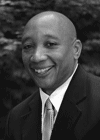
Incorporating Diverse Voices and Representations in Mathematics Teaching and Learning
By Robert Q. Berry, October 2019, NCTM president
The student population in our schools and classrooms is increasingly diverse, with students of color making up the majority of those attending public schools. Many schools and classrooms include children who live in communities whose voices have been historically marginalized. I believe that in a democratic society, all voices deserve to be heard, and as educators, we must create the space and opportunities so that more voices are heard and more communities have access to high-quality mathematics teaching and learning. Shifts in the student population demand that we teach and use curricular materials to meet the needs of an increasingly diverse student population. Teachers must not only differentiate curriculum and instruction but also connect learning to students’ identities, interests, and cultures.
I recently reviewed the Seattle Public Schools proposed K–12 Math Ethnic Studies Framework, which has learning targets and essential questions associated with each of four themes:
1. Origins, Identity, and Agency. The ways in which we view ourselves as mathematicians and members of broader mathematical communities. Mathematical theory and application are rooted in the ancient histories of people and empires of color.
2. Power and Oppression. The ways in which individuals and groups define mathematical knowledge to see Western mathematics as the only legitimate expression of mathematical identity and intelligence.
3. History of Resistance and Liberation. The stories, places, and people who helped liberate people and communities of color using math, engineering, and technology.
4. Reflection and Action. Fostering a sense of advocacy, empowerment, and action in the students that creates internal motivation to engage in and contribute to their identities as mathematicians.
The theme of Origins, Identity, and Agency aligns, in many ways, with the recommendation of equitable teaching practices described in Catalyzing Change in High School Mathematics: Initiating Critical Conversations (NCTM 2018). Seattle’s framework pushes the field of mathematics education forward toward incorporating the marginalized voices not often heard in the field as well as including the contributions of people of color to the field of mathematics.
Many teachers of mathematics have incorporated culturally responsive teaching (CRT) and culturally relevant pedagogy (CRP) as a means for incorporating diverse voices and broader representation of diverse communities in mathematics. Such CRP and CRT as the Seattle Public Schools framework acknowledge the historically rooted power dynamics between Western mathematics and ethnomathematics. It incorporates the cultural knowledge and histories of communities of color, and it attends to equipping learners with the knowledge to use mathematics to understand and critique the world.
Read more:
https://tinyurl.com/v6opgwg